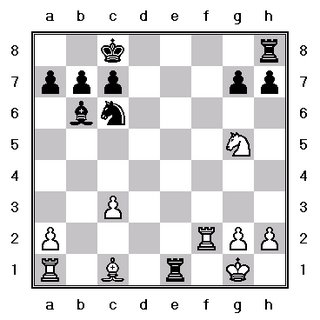The game was Staunton-Horwitz, London 1846. For homework, study the game.
1.e4 e5 2.Nf3 Nc6 3.d4 exd4 4.Bc4 Bb4 5.c3 dxc3 6.bxc3 Ba5 7.0-0 d6 8.e5 (see Diagram 1)
White is threatening to open the e-file and play Re1+. Now Black played 8...Be6, to exchange the powerful White bishop on c4.
9.Bxe6 fxe6 10.exd6 Qxd6
Black captures with the Queen, as he wants to trade pieces, being a pawn up.
11.Qb6 0-0-0 12.Ng5 Rd7 13.Nxe6 Bb6 14.Ng5 Nh6 15.Nd2 Ng4 16.Ndf3
This is a mistake. Better was Ngf3, but then the White queenside pieces have a hard time getting out.
16...Nxf2 17.Rxf2 Qd1+ and White resigned because of 18.Qxd1 Rxd1#.

The b6-bishop pins the f2-rook to the White king, allowing Black this back-rank checkmate.
What did we learn from this game?
1.After 8...Be6, we learn to trade very powerful attacking pieces. Once traded, they can't hurt you anymore!
2.After 10...Qxd6. When you are a pawn up, trade pieces!
3.In the fnial position, White had bank-rank problems. It is important to give your king a little bit of air with h2-h3 or g2-g3 (h7-h6 or g7-g6 if you have Black).
How to study this game for homework:
Set up the pieces on the chessboard, read through the game and play the moves on the board. This will help you learn the game and also practice reading and writing chess notation.
To see this game on your computer, you can go here.
Good luck with your chess studies!


No comments:
Post a Comment